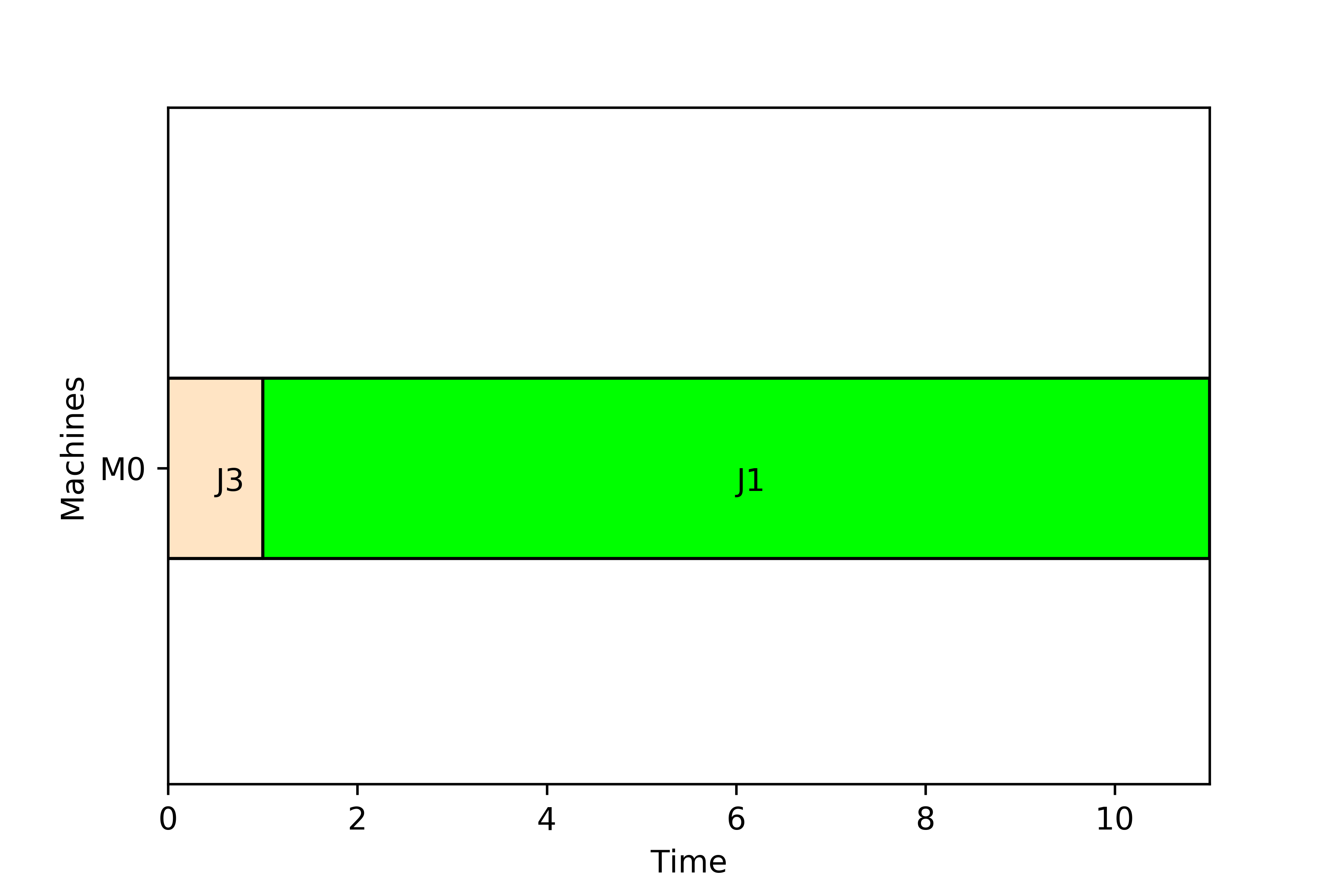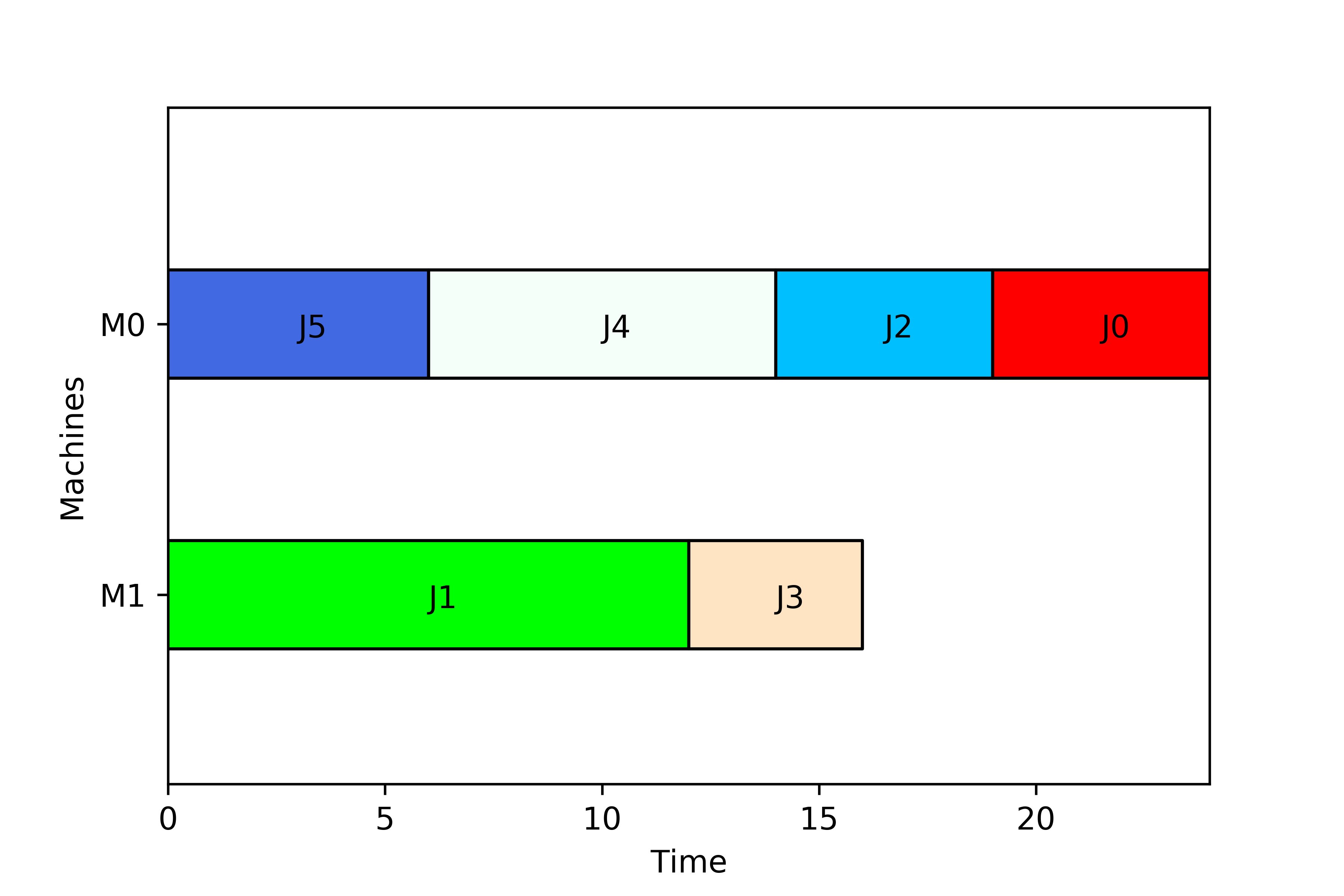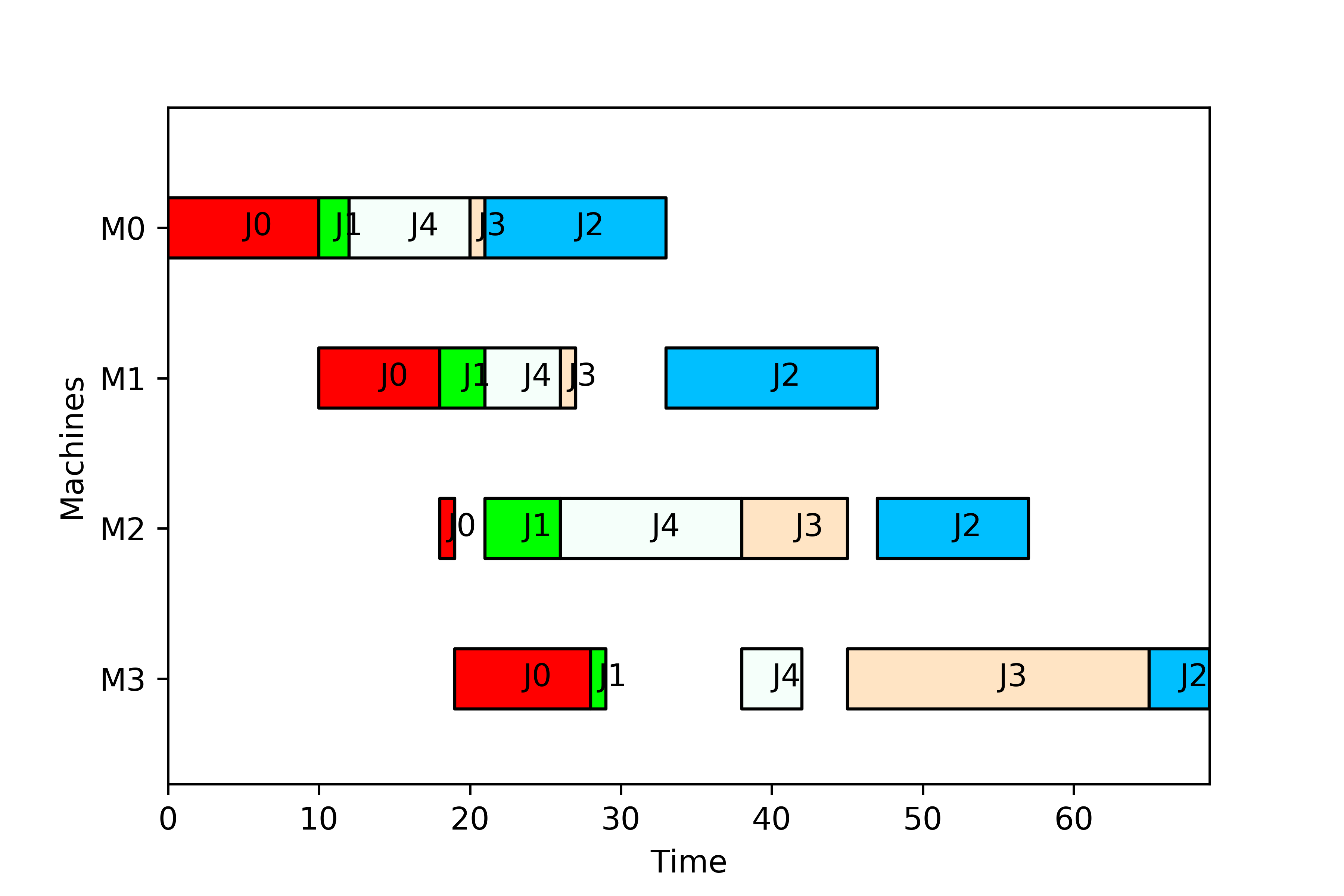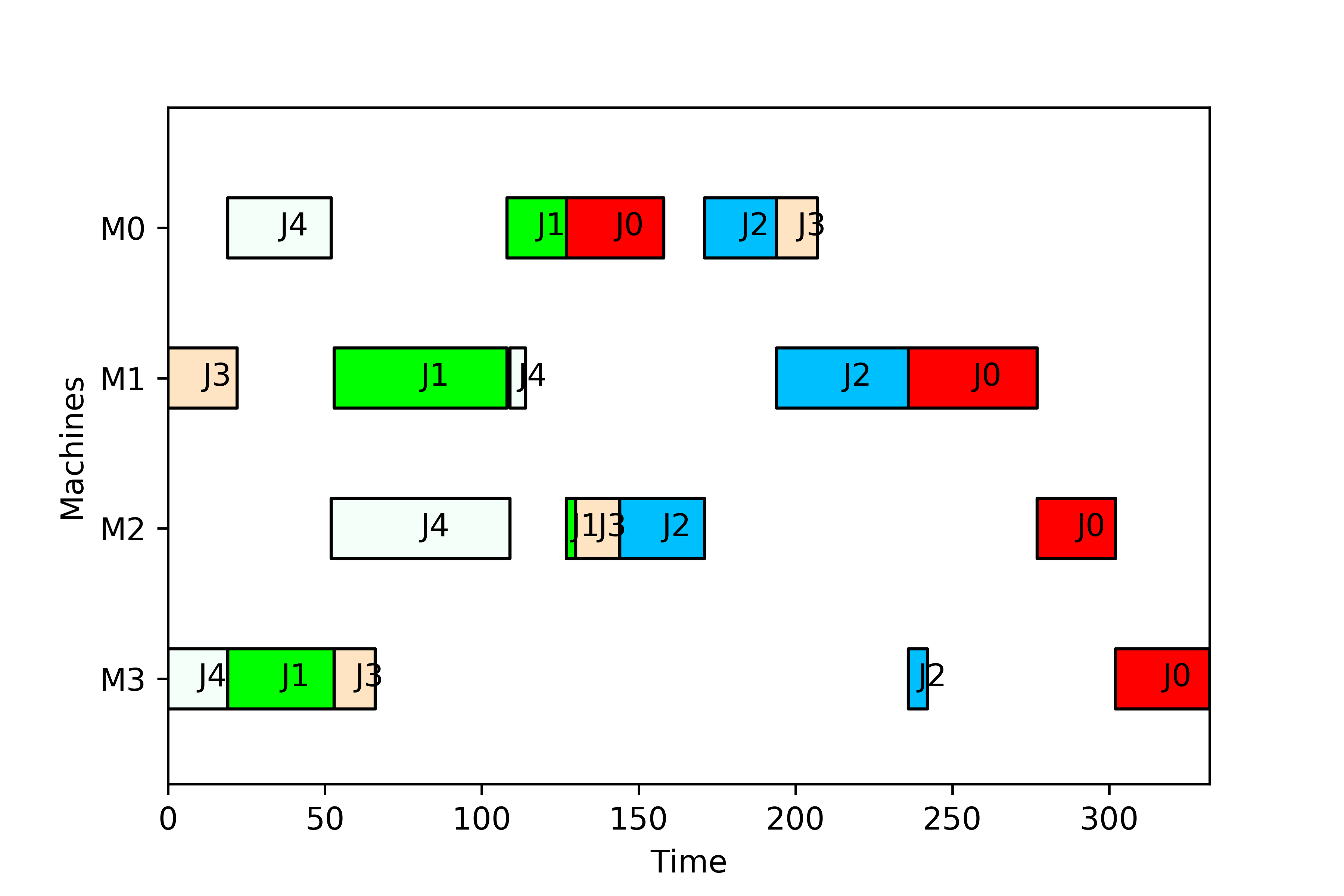-
Notifications
You must be signed in to change notification settings - Fork 1
List of scheduling environments
In the next sections, the scheduling models (layouts) currently implemented in scheptk is listed. The creation and usage of customised scheduling models is discussed here. The standard scheduling models implemented in scheptk are the following:
-
Single Machine (
SingleMachineclass) -
Parallel Machines (
ParalleMachinesclass) -
Unrelated Machines (
UnrelatedMachinesclass) -
Flow Shop (
FlowShopclass) -
Job Shop (
JobShopclass) -
Open Shop (
OpenShopclass)
The SingleMachine class serves to model a single machine scheduling problem, where a set of jobs have to be processed on a single machine. This is the Gantt chart produced with the instance in the file and the solution procedure in the sample.

Some of the Attributes are mandatory and produce an error if not found when loading the instance file. Others are optional, but they may produce errors in some cases if missing (e.g. if due dates are ommitted, then due-date related criteria cannot be computed).
- Mandatory:
jobs- number of jobspt- processing times (a list containing the processing time of each job)
- Optional:
w- weights. The weight of each job. If not specified, they are assumed to be 1.0r- release dates. The earliest starting time of each job. If not specified, they are assumed to be 0dd- due dates. The due date of each job. If not specified, they are assumed to be infinite
A typical instance is the following:
[PT=2,10,1,1]
[DD=11,13,13,14]
[W=2.0,1,1,2]
[R=0,0,0,0]
[JOBS=4]
A semiactive (no idle) schedule for a single machine typically consists of providing an order (sequence) in which the jobs are processed in the machine, i.e.
solution = [3,2,0,1]
from scheptk.scheptk import SingleMachine
instance = SingleMachine('test_single.txt')
solution = [3,2,0,1]
print('Max. tardiness is {}'.format(instance.Tmax(solution)))
instance.print_schedule(solution, '..\\documentation\\images\\single_sample.png')The ParallelMachines class serves to model a (identical) parallel machine scheduling problem. Each job has to be processed in one machine. This is the Gantt chart produced with the instance in the sample and the solution in the solution encoding section.

Some of the Attributes are mandatory and produce an error if not found when loading the instance file. Others are optional, but they may produce errors in some cases if missing (e.g. if due dates are ommitted, then due-date related criteria cannot be computed).
- Mandatory:
jobs- number of jobsmachines- number of machinespt- processing times (a list containing the processing time of each job), which is the same in all machines
- Optional:
w- weights. The weight of each job. If not specified, they are assumed to be 1.0r- release dates. The earliest starting time of each job. If not specified, they are assumed to be 0dd- due dates. The due date of each job. If not specified, they are assumed to be infinite
A typical instance is the following:
[PT=2,10,4,5,7,9,1,8]
[JOBS=8]
[MACHINES=3]
There are several possibilites for encoding a solution. Perhaps the easiest is to provide an order (sequence) in which the jobs enter the system and assign the job to the machine according to the ECT (Earliest Completion Time) rule, i.e. the job is allocated to the machine that finishes first. Ties are broken according to the index of the machine, so machines with lower index have higher priority for the allocation.
solution = [1, 5, 6, 2, 3, 4, 7, 0]
The UnrelatedMachines class serves to model parallel, but not identical machines. Each job has to be processed in one of these machines, but the processing times are machine-dependent. This is the Gantt chart produced with the instance in the sample and the solution in the solution encoding section.

Some of the Attributes are mandatory and produce an error if not found when loading the instance file. Others are optional, but they may produce errors in some cases if missing (e.g. if due dates are ommitted, then due-date related criteria cannot be computed).
- Mandatory:
jobs- number of jobsmachines- number of machinespt- processing times of each job on each machine. It is a list of lists, i.e. a list containing the processing times of all jobs on the machine, soinstance.pt[i][j]indicates the processing times of jobjon machinei.
- Optional:
w- weights. The weight of each job. If not specified, they are assumed to be 1.0r- release dates. The earliest starting time of each job. If not specified, they are assumed to be 0dd- due dates. The due date of each job. If not specified, they are assumed to be infinite
A typical instance is the following:
[JOBS=6]
[MACHINES=2]
[PT=5,13,5,2,8,6;9,12,10,4,3,10]
There are several possibilites for encoding a solution. Perhaps the easiest is to provide an order (sequence) in which the jobs enter the system and assign the job to the machine according to the ECT (Earliest Completion Time) rule, i.e. the job is allocated to the machine that would first complete this job. Ties are broken according to the index of the machine, so machines with lower index have higher priority for the allocation.
solution = [5, 1, 4, 2, 3, 0]
from scheptk.scheptk import UnrelatedMachines
instance = UnrelatedMachines('test_unrelated.txt')
sequence = [5, 1, 4, 2, 3, 0]
instance.print_schedule(sequence)
print(instance.Cj(sequence))The FlowShop class serves to model the permutation flowshop scheduling problem. Each job has to be processed in all machines in the same order. This is the Gantt chart produced with the instance in the sample and the solution in the solution encoding section.

Some of the Attributes are mandatory and produce an error if not found when loading the instance file. Others are optional, but they may produce errors in some cases if missing (e.g. if due dates are ommitted, then due-date related criteria cannot be computed).
- Mandatory:
jobs- number of jobsmachines- number of machinespt- processing times of each job on each machine. It is a list of lists, i.e. a list containing the processing times of all jobs on the machine, soinstance.pt[i][j]indicates the processing times of jobjon machinei.
- Optional:
w- weights. The weight of each job. If not specified, they are assumed to be 1.0r- release dates. The earliest starting time of each job. If not specified, they are assumed to be 0dd- due dates. The due date of each job. If not specified, they are assumed to be infinite
A typical instance is the following:
[JOBS=6]
[MACHINES=2]
[PT=5,13,5,2,8,6;9,12,10,4,3,10]
A sequence indicating the order in which the jobs are going to be processed in all machines.
solution = [0,1,4,3,2]
from scheptk.scheptk import FlowShop
instance = FlowShop('test_flowshop.txt')
sequence = [0,1,4,3,2]
instance.print_schedule(sequence)
makespan = instance.Cmax(sequence)The JobShop class serves to model the jobshop scheduling problem. Each job has to be processed in all machines in an order given by a routing matrix. This is the Gantt chart produced with the instance in the sample and the solution in the solution encoding section.

Some of the Attributes are mandatory and produce an error if not found when loading the instance file. Others are optional, but they may produce errors in some cases if missing (e.g. if due dates are ommitted, then due-date related criteria cannot be computed).
- Mandatory:
jobs- number of jobsmachines- number of machinespt- processing times of each job on each machine. It is a list of lists, i.e. a list containing the processing times of all jobs on the machine, soinstance.pt[i][j]indicates the processing times of jobjon machinei.rt- routing matrix. It is a list of lists, i.e. a list containing the routing of each jobs across the machines, soinstance.rt[j]indicates the routing of jobj, i.e. a list of the machines to be visited by the job soinstance.rt[j][i]indicates the machine to be visited by jobjin the i-th order.
- Optional:
w- weights. The weight of each job. If not specified, they are assumed to be 1.0r- release dates. The earliest starting time of each job. If not specified, they are assumed to be 0dd- due dates. The due date of each job. If not specified, they are assumed to be infinite
A typical instance is the following:
[JOBS=5]
[MACHINES=4]
[PT=31,19,23,13,33;41,55,42,22,5;25,3,27,14,57;30,34,6,13,19]
[RT=0,1,2,3;3,1,0,2;2,0,1,3;1,3,2,0;3,0,2,1]
[DD=300,0,0,0,0]
[R=0,0,0,0,0]
There are several possibilities for encoding a solution in a Job Shop. Perhaps the easiest is to provide an extended sequence where the jobs iteratively are assigned to the corresponding machine in their routing. solution =[4, 4, 3, 1, 1, 3, 1, 4, 1, 3, 2, 0, 4, 2, 2, 2, 0, 0, 0, 3] indicates that first job 4 is assigned to its first machine in its routing matrix, then job 4 is assigned to its second machine, then job 3 is assigned to its first machine, etc.
From version 0.1.3 on, the method get_sequence(solution) returns the order in which the jobs are processed machine corresponding to the solution solution, i.e. the value of job_order in following code (where test_jobshop.txt is the instance above) is [3, 1, 2, 0, 4].
from scheptk.scheptk import JobShop
instance = JobShop('test_jobshop.txt')
solution = [3, 3, 3, 3, 1, 2, 2, 0, 2, 1, 0, 0, 0, 4, 4, 4, 4, 2, 1, 1]
job_order = instance.get_sequence(solution)from scheptk.scheptk import JobShop
instance = JobShop('test_jobshop.txt')
sol = [4, 4, 3, 1, 1, 3, 1, 4, 1, 3, 2, 0, 4, 2, 2, 2, 0, 0, 0, 3]
print(sol)
print('Cmax={}'.format(instance.Cmax(sol)))
print('SumCj={}'.format(instance.SumCj(sol)))
instance.write_schedule(sol, 'jobshop.sch')
instance.print_schedule(sol, '..\\documentation\\images\\jobshop_sample.png')The OpenShop class serves to model the open shop scheduling problem. Each job has to be processed in all machines in any order (no routing matrix). This is the Gantt chart produced with the instance in the sample and the solution in the solution encoding section.

Some of the Attributes are mandatory and produce an error if not found when loading the instance file. Others are optional, but they may produce errors in some cases if missing (e.g. if due dates are ommitted, then due-date related criteria cannot be computed).
- Mandatory:
jobs- number of jobsmachines- number of machinespt- processing times of each job on each machine. It is a list of lists, i.e. a list containing the processing times of all jobs on the machine, soinstance.pt[i][j]indicates the processing times of jobjon machinei.
- Optional:
w- weights. The weight of each job. If not specified, they are assumed to be 1.0r- release dates. The earliest starting time of each job. If not specified, they are assumed to be 0dd- due dates. The due date of each job. If not specified, they are assumed to be infinite
A typical instance is the following:
[JOBS=3]
[MACHINES=3]
[PT=10,5,18;15,20,6;10,16,8]
Here it is used the so-called operations sequence solution encoding. Here it is an example of such encoding for a 3 job, 3 machine open shop instance:
| Operation | 0 | 1 | 2 | 3 | 4 | 5 | 6 | 7 | 8 |
|---|---|---|---|---|---|---|---|---|---|
| Machine | 0 | 0 | 0 | 1 | 1 | 1 | 2 | 2 | 2 |
| Job | 0 | 1 | 2 | 0 | 1 | 2 | 0 | 1 | 2 |
Therefore sol=[7,5,4,0,1,6,3,2,8] indicates that job 1 is first processed on machine 2, then job 2 is processed on machine 1, next job 1 is processed on machine 1, job 0 on machine 0 and so forth.
From version 0.1.3 on, several methods have been developed to ease handling the solutions:
-
get_job(op): returns the job corresponding to the operationop, i.e. the value ofjobin following code (wheretest_openshop.txtis a 3-machine, 3-job instance) is 2.from scheptk.scheptk import OpenShop instance = OpenShop('test_openshop.txt') job = instance.get_job(5)
-
get_machine(op): returns the machine corresponding to the operationop, i.e. the value ofmachinein following code (wheretest_openshop.txtis a 3-machine, 3-job instance) is 1.from scheptk.scheptk import OpenShop instance = OpenShop('test_openshop.txt') job = instance.get_machine(5)
-
get_sequence(solution): returns the order in which the jobs are processed machine corresponding to the solutionsolution, i.e. the value ofjob_orderin following code (wheretest_openshop.txtis a 3-machine, 3-job instance) is [1,2,0].from scheptk.scheptk import OpenShop instance = OpenShop('test_openshop.txt') solution = [7,5,4,0,1,6,3,2,8] job_order = instance.get_sequence(solution)
from scheptk.scheptk import OpenShop
instance = OpenShop('test_openshop.txt')
sol = [7,5,4,0,1,6,3,2,8]
print(sol)
print("Cmax={}".format(instance.Cmax(sol)))
instance.write_schedule(sol, 'openshop.sch')